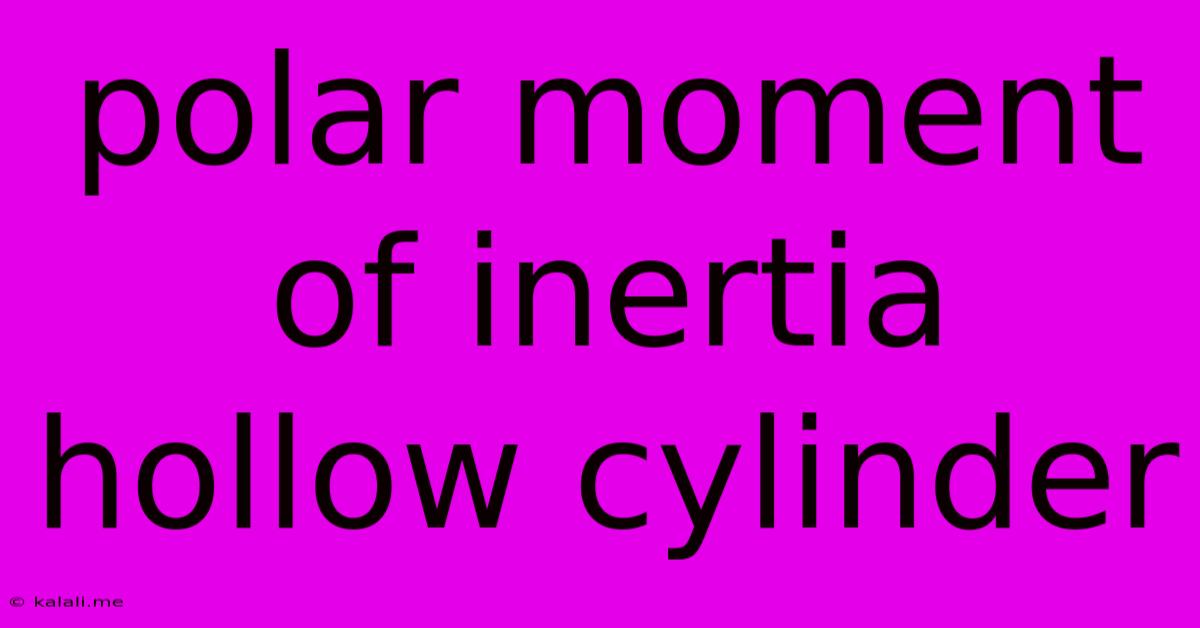Polar Moment Of Inertia Hollow Cylinder
Kalali
Jun 13, 2025 · 3 min read

Table of Contents
Polar Moment of Inertia of a Hollow Cylinder: A Comprehensive Guide
The polar moment of inertia, often denoted as J or Ip, is a measure of an object's resistance to torsional deformation (twisting). Understanding this property is crucial in various engineering applications, especially when dealing with rotating shafts and cylinders under stress. This article will delve into the calculation of the polar moment of inertia for a hollow cylinder, providing a clear explanation and relevant formulas.
What is Polar Moment of Inertia?
The polar moment of inertia represents the sum of the moments of inertia of a cross-section about the x and y axes. Imagine a hollow cylinder subjected to a twisting force; its polar moment of inertia determines how much it resists this twisting. A higher polar moment of inertia indicates greater resistance to torsion. This is especially important in design considerations where minimizing torsional deflection and maximizing strength are critical factors. Examples include designing axles for vehicles, drive shafts in machinery, and structural elements subjected to torsional loads.
Calculating the Polar Moment of Inertia for a Hollow Cylinder
For a hollow cylinder, the calculation involves considering the area and its distribution relative to the central axis. The formula is derived from integrating the square of the distance of each infinitesimal area element from the central axis. The result is:
J = (π/2) (Ro⁴ - Ri⁴)
Where:
- J represents the polar moment of inertia.
- Ro is the outer radius of the hollow cylinder.
- Ri is the inner radius of the hollow cylinder.
This formula highlights the importance of both the outer and inner radii in determining the resistance to torsion. A larger difference between Ro and Ri results in a larger polar moment of inertia, indicating greater torsional stiffness.
Derivation of the Formula
The formula is derived through integration. We consider a thin annular ring of radius r and thickness dr within the hollow cylinder. The area of this ring is dA = 2πr dr. The moment of inertia of this ring about the central axis is dJ = r² dA = 2πr³ dr. Integrating this expression from the inner radius Ri to the outer radius Ro gives us the total polar moment of inertia:
J = ∫(Ri to Ro) 2πr³ dr = (π/2) (Ro⁴ - Ri⁴)
Practical Applications and Considerations
The polar moment of inertia of a hollow cylinder finds wide application in various fields:
- Mechanical Engineering: Designing shafts, axles, and other rotating components. Choosing materials and dimensions to withstand torsional stresses.
- Civil Engineering: Analyzing the torsional behavior of columns and other structural elements.
- Aerospace Engineering: Designing lightweight yet strong components for aircraft and spacecraft.
- Automotive Engineering: Optimizing the design of drive shafts and axles to reduce weight and enhance performance.
Factors Affecting Polar Moment of Inertia
Several factors influence the polar moment of inertia of a hollow cylinder:
- Outer Radius (Ro): A larger outer radius significantly increases the polar moment of inertia.
- Inner Radius (Ri): A larger inner radius reduces the polar moment of inertia.
- Material Properties: While not directly in the formula, the material's shear modulus influences the angle of twist under a given torque.
Conclusion
Understanding the polar moment of inertia of a hollow cylinder is critical for engineers in various disciplines. This value is essential in designing strong and reliable structures and components that can withstand torsional loads. The formula provided, derived through integration, offers a practical and accurate method for determining this crucial property. By considering the outer and inner radii, engineers can optimize designs to achieve the desired torsional stiffness and resistance. Remember to always consider material properties alongside the geometric factors for a complete understanding of the component's behavior under stress.
Latest Posts
Latest Posts
-
University Of San Francisco Gpa Requirement
Jun 14, 2025
-
After Birth The Umbilical Vein Becomes The
Jun 14, 2025
-
University Of Cincinnati Sat Score Requirements
Jun 14, 2025
-
Can You Change Your Sat Test Date
Jun 14, 2025
-
What Is The Opposite Of Release
Jun 14, 2025
Related Post
Thank you for visiting our website which covers about Polar Moment Of Inertia Hollow Cylinder . We hope the information provided has been useful to you. Feel free to contact us if you have any questions or need further assistance. See you next time and don't miss to bookmark.